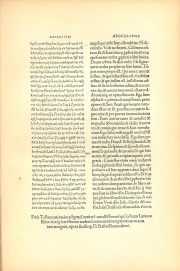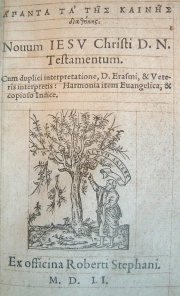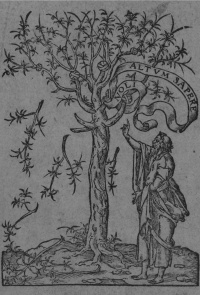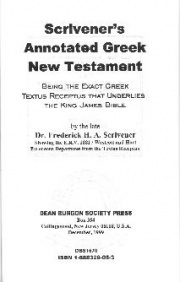Textus Receptus
From Textus Receptus
(→Further reading) |
(→Scrivener) |
||
| Line 51: | Line 51: | ||
====Scrivener==== | ====Scrivener==== | ||
| - | The Greek New | + | The Greek New Testament which is sold by the [[Trinitarian Bible Society]] today, was edited by [[Frederick Henry Ambrose Scrivener]] |
is the same as the text of [[Theodore Beza|Beza]]'s [[1598 AD|1598]] fourth edition, except for [[191 Variations in Scrivener’s 1881 Greek New Testament from Beza's 1598 Textus Receptus|191 places]], in which [[Frederick Henry Ambrose Scrivener|Scrivener]] amended his text using earlier editions of the [[Textus Receptus]]. | is the same as the text of [[Theodore Beza|Beza]]'s [[1598 AD|1598]] fourth edition, except for [[191 Variations in Scrivener’s 1881 Greek New Testament from Beza's 1598 Textus Receptus|191 places]], in which [[Frederick Henry Ambrose Scrivener|Scrivener]] amended his text using earlier editions of the [[Textus Receptus]]. | ||
Revision as of 21:13, 14 October 2011

Textus Receptus (Latin: "received text") is the name subsequently given to the succession of printed Greek texts of the New Testament which constituted the translation base for the original German Luther Bible, for the translation of the New Testament into English by William Tyndale, the King James Version, and for most other Reformation-era New Testament translations throughout Western and Central Europe. The series originated with the first printed Greek New Testament to be published; a work undertaken in Basel by the Dutch scholar and Christian humanist Desiderius Erasmus in 1516. Erasmus had devoted at least 15 years to the project, studying and collecting manuscripts from all over Europe. He had collated many Greek manuscripts of the NT and was surrounded by all the commentaries and translations by the writings of Origen, Cyprian, Ambrose, Basil, Chrysostom, Cyril, Jerome and Augustine. Erasmus had access to Codex Vaticanus, D, and Codex Bezae, but also rejected them as corrupt, as did the King James Translators. The text Erasmus chose had an outstanding history in the Greek, Syrian and Waldensian churches.
Contents |
Received Text
The origin of the term "Textus Receptus" comes from the publisher's preface to the 1633 edition produced by Bonaventure and Abraham Elzevir, two brothers and printers at Leiden:
- textum ergo habes, nunc ab omnibus receptum, in quo nihil immulatum aut corruptum damus, translated "so you hold the text, now received by all, in which nothing corrupt."
The two words, textum and receptum, were modified from the accusative to the nominative case to render textus receptus. Over time, this term has been retroactively applied to Erasmus' editions, as his work served as the basis of the others. The term "Textus Receptus" has also been used to refer to the early church fathers quotes containing "Textus Receptus" type readings, and it is also used as a synonym for Byzantine type texts, the Majority Text, and any reading that is supportive of the Textus Receptus used to underlie the King James Version.
History of the Printed Textus Receptus
Complutensian Polyglot
See Also Complutensian Polyglot
The Complutensian Polyglot is the name given to the first printed polyglot of the entire Bible, initiated and financed by Cardinal Francisco Jiménez de Cisneros. It contained the first printed Greek New Testament. Although the New Testament was printed in 1514 its release was delayed until the Old Testament was completed in 1517. By this time Erasmus had printed his Novum Instrumentum omne and obtained an exclusive four-year publishing privilege from Emperor Maximilian and Pope Leo X in 1516. Because of Erasmus' exclusive privilege, publication of the Polyglot was delayed until Pope Leo X could sanction it in 1520. It is believed to have not been distributed widely before 1522.
Novum Instrumentum omne
See Also Novum Instrumentum omne
Erasmus had been working for years on two projects: a collation of Greek texts and a fresh Latin New Testament. In 1512, he began his work on a fresh Latin New Testament. He collected all the Vulgate manuscripts he could find to create a critical edition. Then he polished the Latin. He declared, "It is only fair that Paul should address the Romans in somewhat better Latin." Erasmus was keen to amend the old Vulgate and poured his life into the project: "My mind is so excited at the thought of emending Jerome’s text, with notes, that I seem to myself inspired by some god. I have already almost finished emending him by collating a large number of ancient manuscripts, and this I am doing at enormous personal expense."
While his intentions for publishing a fresh Latin translation are clear, it is less clear why he included the Greek text. Though some speculate that he intended on producing a critical Greek text or that he wanted to beat the Complutensian Polyglot into print, there is no evidence to support this. Rather his motivation seems to be simpler: he included the Greek text to prove the superiority of his Latin version. He wrote,
- "There remains the New Testament translated by me, with the Greek facing, and notes on it by me."
Erasmus, who had worked as a scribe himself, further demonstrated the reason for the inclusion of the Greek text when defending his work:
- "But one thing the facts cry out, and it can be clear, as they say, even to a blind man, that often through the translator’s clumsiness or inattention the Greek has been wrongly rendered; often the true and genuine reading has been corrupted by ignorant scribes, which we see happen every day, or altered by scribes who are half-taught and half-asleep."
Erasmus's new work was published by Froben of Basel in 1516 and thence became the first published Greek New Testament, the Novum Instrumentum omne, diligenter ab Erasmo Rot. Recognitum et Emendatum. Erasmus was surrounded with Bible manuscripts from his childhood in the 1460s, until the publication of his Greek Text in 1516. This is over 40 years! He worked for a dozen years on the text itself. “The preparation had taken years” (Durant, p. 283).
He used manuscripts: 1, 1rK, 2e, 2ap, 4ap, 7, 817. The second edition used the more familiar term Testamentum instead of Instrumentum, and eventually became a major source for Luther's German translation. In second edition (1519) Erasmus used also Minuscule 3.
With the third edition of Erasmus' Greek text (1522) the Comma Johanneum was included, because a single 16th-century Greek manuscript (Codex Montfortianus) had subsequently been found to contain it, though Erasmus had expressed doubt as to the authenticity of the passage in his Annotations. Popular demand for Greek New Testaments led to a flurry of further authorized and unauthorized editions in the early sixteenth century; almost all of which were based on Erasmus's work and incorporated his particular readings, although typically also making a number of minor changes of their own.
The overwhelming success of Erasmus' Greek New Testament completely overshadowed the Latin text upon which he had focused. Many other publishers produced their own versions of the Greek New Testament over the next several centuries.
Editio Regia
See Also Editio Regia
Robert Estienne, known as Stefanus (1503-1559), a printer from Paris, edited four times the Greek New Testament, 1546, 1549, 1550, and 1551, the last in Geneva. The first two are among the neatest Greek texts known, and are called O mirificam; the third edition is a splendid masterpiece of typographical skill. It has critical apparatus in which quoted manuscripts referred to the text. Manuscripts were marked by symbols (from α to ις). He used Polyglotta Complutensis (symbolized by α) and 15 Greek manuscripts. In this number manuscripts: Codex Bezae, Codex Regius, minuscules 4, 5, 6, 2817, 8, 9. The third edition is known as the Editio Regia; the edition of 1551 contains the Latin translation of Erasmus and the Vulgate, is exceedingly rare. It was in this edition that the division of the New Testament into verses was for the first time introduced.
Beza
The third edition of Estienne was used by as the basis of the Greek new Testament editions of Theodore Beza (1519-1605), who edited it nine times between 1565 and 1604. In the critical apparatus of the second edition he used the Codex Claromontanus and the Syriac New Testament published by Emmanuel Tremellius in 1569. Codex Bezae was twice referenced (as Codex Bezae and β' of Estienne).
Scrivener
The Greek New Testament which is sold by the Trinitarian Bible Society today, was edited by Frederick Henry Ambrose Scrivener is the same as the text of Beza's 1598 fourth edition, except for 191 places, in which Scrivener amended his text using earlier editions of the Textus Receptus.
Textual criticism and the Textus Receptus
John Mill (1645-1707), collated textual variants from 82 Greek manuscripts. In his Novum Testamentum Graecum, cum lectionibus variantibus MSS (Oxford 1707) he reprinted the unchanged text of the Editio Regia, but in the index he enumerated 30,000 textual variants.
Shortly after Mill published his edition, Daniel Whitby (1638-1725), attacked his work. He claimed that the autographs of the New Testament were identical to the Textus Receptus, and that the text had never been corrupted. He believed the text of the Holy Scripture was endangered by the 30,000 variants in Mill's edition. Whitby claimed that every part of the New Testament should be defended against these variants.
Johann Albrecht Bengel (1687-1752), in 1725 edited Prodromus Novi Testamenti Graeci Rectè Cautèque Adornandi, in 1734 edited Novum Testamentum Graecum. Bengel divided manuscripts into families and subfamilies. He favoured (lectio difficilior potior).
Johann Jakob Wettstein. His Apparatus was fuller than of any previous editor. He introduced the practice of indicating the ancient manuscripts by capital Roman letters and the later manuscripts by Arabic numerals. He published in Basel Prolegomena ad Novi Testamenti Graeci (1731).
J. J. Griesbach (1745-1812) combined the principles of Bengel and Wettstein. He enlarged the Apparatus by a more citations from the Fathers, and various versions, such as the Gothic, the Armenian, and the Philoxenian. Griesbach distinguished a Western, an Alexandrian, and a Byzantine Recension. Christian Frederick Matthaei (1744-1811) was a Griesbach opponent.
Karl Lachmann (1793-1851), was the first who broke with the Textus Receptus. His object was to restore the text to the form in which it had been read in the ancient Church about A.D. 380. He used the oldest known Greek and Latin manuscripts.
Westcott and Hort, The New Testament in the Original Greek (1881).
The majority of textual critical scholars since the late 19th Century, have adopted an eclectic approach to the Greek New Testament; with the most weight given to the earliest extant manuscripts which tend mainly to be Alexandrian in character; the resulting eclectic Greek text departing from the Textus Receptus in around 6,000 readings. A significant minority of textual scholars, however, maintain the priority of the Byzantine text-type; and consequently prefer the "Majority Text". No school of textual scholarship now continues to defend the priority of the Textus Receptus; although this position does still find adherents amongst the King-James-Only Movement, and other independent Protestant groups hostile to the whole discipline of text criticism—as applied to scripture; and suspicious of any departure from Reformation traditions.
Defense of the Textus Receptus
Frederick von Nolan, a 19th century historian and Greek and Latin scholar, spent 28 years attempting to trace the Textus Receptus to apostolic origins. He was an ardent advocate of the supremacy of the Textus Receptus over all other editions of the Greek New Testament, and argued that the first editors of the printed Greek New Testament intentionally selected the texts they did because of their superiority and disregarded other texts which represented other text-types because of their inferiority.
- It is not to be conceived that the original editors of the [Greek] New Testament were wholly destitute of plan in selecting those manuscripts, out of which they were to form the text of their printed editions. In the sequel it will appear, that they were not altogether ignorant of two classes of manuscripts; one of which contains the text which we have adopted from them; and the other that text which has been adopted by M. Griesbach.
Regarding Erasmus, Nolan stated:
Nor let it be conceived in disparagement of the great undertaking of Erasmus, that he was merely fortuitously right. Had he barely undertaken to perpetuate the tradition on which he received the sacred text he would have done as much as could be required of him, and more than sufficient to put to shame the puny efforts of those who have vainly labored to improve upon his design. [...] With respect to Manuscripts, it is indisputable that he was acquainted with every variety which is known to us, having distributed them into two principal classes, one of which corresponds with the Complutensian edition, the other with the Vatican manuscript. And he has specified the positive grounds on which he received the one and rejected the other.
Regarding 1 John 5:7, the long-standing belief that MS. 61 was created specifically to force Erasmus to add the text is no longer considered a legitimate concern. Metzger himself admits this in the 3rd edition of The Text of the New Testament... when he notes (footnote 2 on p. 292):
What was said about Erasmus promise and his subsequent suspicion that MS. 61 was written expressly to force him to [add 1 John 5:7 to the text], needs to be corrected in light of the research of H.J. de Jonge, a specialist in Erasmian studies who finds no explicit evidence that supports this frequently made assertion.
Textus Receptus was defended by Burgon in his The Revision Revised (1881), by Edward Miller in A Guide to the Textual Criticism of the New Testament. According to Burgon Codex Alexandrinus, and Codex Ephraemi are older than Sinaiticus, and Vaticanus. Peshitta originated from the 2nd century. Arguments of Miller were of the same kind. Hills took different point of view. Hills rejected text of majority (Byzantine text) and according to him Textus Receptus was the closest text to the autographs. He concluded that Erasmus was divinely guided when he introduced Latin Vulgate readings into his Greek text and argued for the authenticity of the Comma Johanneum.
Hebrew Textus Receptus
In certain circles of scholarship the term Textus Receptus is defined as a reference to all Byzantine type texts, or to any reformation type Greek text, or sometimes to a specific edition of the Greek New Testament, such as the 1598 text of Beza, or the 1550 text of Stephanus, or other individual Greek New Testament editions. The Hebrew Masoretic Text has been called the Hebrew Textus Receptus, or simply the Hebrew received text, specifically refering to the Bomberg 1524-25 edition.
See also
- Other text-types
- Other articles
- New Testament
- Vulgate
- King-James-Only Movement
- Editio Regia
- Novum Instrumentum omne
- Theodore Beza
- Dean Burgon Society
- The Word of God for All Nations by Phil Stringer A massive list of bibles, based upon the Textus Receptus
Notes
Further reading
Defence of the Textus Receptus
- Edward F. Hills, The King James Bible Defended ISBN: 0-915923-00-9
Modern Textual Criticism
- S. P. Tregelles, The Printed Text of the Greek New Testament, London 1854.
- Bruce M. Metzger, B. D. Ehrman, The Text of the New Testament: Its Transmission, Corruption and Restoration, Oxford University Press, 2005.
- W. W. Combs, Erasmus and the textus receptus, DBSJ 1 (Spring 1996).
- Daniel B. Wallace, Some Second Thoughts on the Majority Text. Bibliotheca Sacra 146 (1989): 270-290.
- Dr James White. King James Only Controversy, Can You Trust the Modern Translations? Bethany House, 1995.




